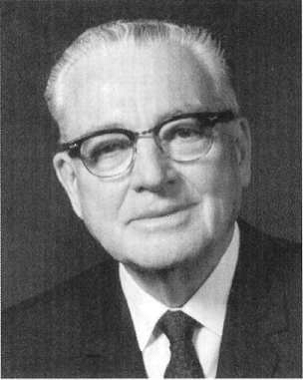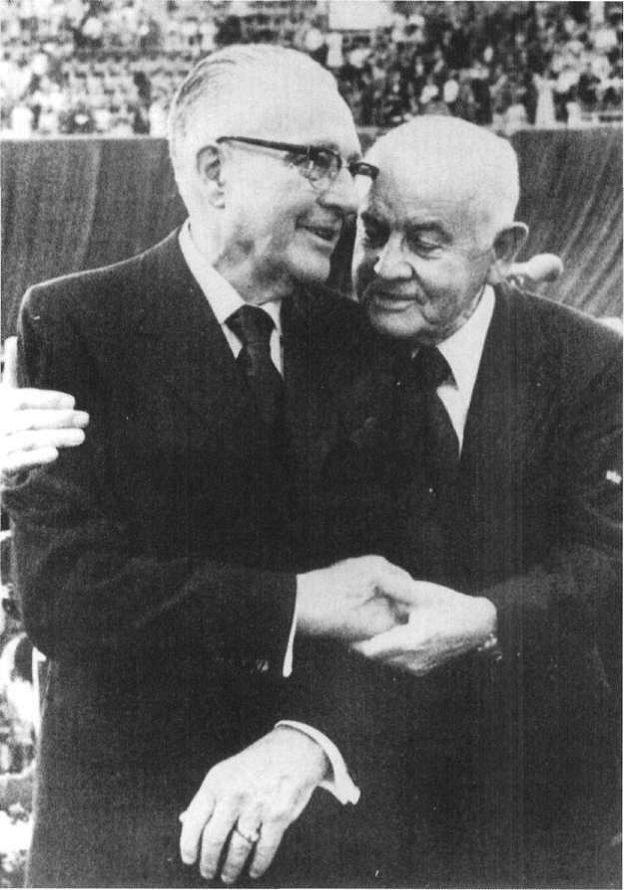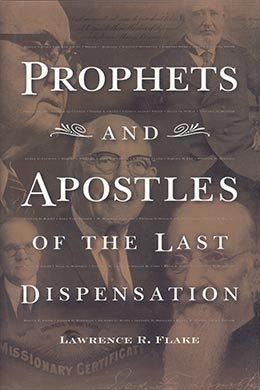Harold Bingham Lee
Lawrence R. Flake, Prophets and Apostles of the Last Dispensation (Provo, UT: Religious Studies Center, Brigham Young University, 2001), 105–12.

Born: 28 March 1899, Clifton, Idaho
Quorum of the Twelve Apostles: 10 April 1941 (age 42)
President of the Quorum of the Twelve and first counselor to President Joseph Fielding Smith: 23 January 1970
President of the Church: 7 July 1972 (age 73)
Died: 26 December 1973 (age 74), Salt Lake City, Utah
The large chapel was filled with hundreds of Latter-day Saint students from three hundred campuses across the nation. Elder Harold B. Lee had just delivered a powerful address and the meeting then closed with prayer. Brother Marion D. Hanks related:
At the end of the prayer, everyone sat in absolute silence. No one moved. Several minutes passed. The room was charged with a perceptible and almost tangible spirit that brought almost everybody to tears. . . .
President Lee was then escorted from the stand. The students arose. About midway down the aisle, the congregation began to sing, “The Spirit of God Like a Fire Is Burning.” As the students left there was no conversation.
Everyone knew we had been greatly blessed with a deep spiritual experience which would not be forgotten.
Not a single one of the students attending the conference felt inclined to attend a dance in their honor that evening. All returned to their rooms to ponder the significant events they had experienced. [1]
Hundreds of thousands of people throughout the Church felt the power of the Spirit of the Lord radiating from President Harold B. Lee. Marion G. Romney, one of his associates in the Quorum of the Twelve, identified the source of this power as being “in his knowledge that he lives in the shadow of the Almighty. To him, his Heavenly Father is a senior partner, daily giving him guidance. His contacts with heaven are direct and regular.” [2] During the Mutual Improvement Association conference of 1969, Elder Lee declared, “I know that Jesus Christ lives and that he’s closer to this Church and appears more often in Holy places than any of us realize excepting sometimes to those whom he makes personal appearance.” [3]
The earthly life of this powerful man in Israel began on a small farm in Clifton, Idaho, where he learned the meaning and dignity of work. “We had everything money could not buy,” he recalled. [4] The prized possession of the family was a piano that Harold B. Lee learned to play with competence. He used his musical talent well and served at one time as chairman of the Church Music Committee. Once when he and his brother were suffering an attack of scarlet fever, their father bought them a coronet and a baritone horn to help them pass the time until their recovery. The boys derived a great deal of pleasure from these instruments and learned to play them well enough to join the local band.
Brother Lee’s father, the bishop of the Clifton Ward, was a wonderful influence on the young prophet-to-be. This good man, Samuel Marion Lee, was the twelfth child born to his mother. All eleven of the other babies had died at birth, and eight days after the arrival of this tiny, premature infant, the mother passed away. Little Samuel was so small that a finger ring could be slipped over his arm, but the Lord preserved him to raise a great apostle and prophet. Harold’s childhood also reflected the loving care of his Father in heaven. Elder Gordon B. Hinckley related this story about President Lee:
As a little boy, he went one day with his father to the fields. His father went off in one direction, leaving the boy to wander in another.
Young Harold saw a group of old tumbled-down farm buildings across the fence. To the little boy they looked like castles to be explored.
He started through the fence, but he heard a quiet voice which said, “Harold, don’t go in there.”
He looked around to see if his father had spoken, but his father was far up in the field. But without challenging the warning or questioning its source, he turned and fled the place. He never knew the reason for that warning, but accepted it for what he felt it to be.
That characteristic, of listening to the whisperings of the still small voice, was practiced throughout his life. [5]
After attending the district school, the Oneida Stake Academy, and the Albion Stake Normal School near his home, he began teaching in a one-room schoolhouse in western Idaho at the age of seventeen. The next year he became principal of the school at Oxford, Idaho, which position he held at the time of his call to the Western States Mission in 1920. While in the mission field, Elder Lee met a talented young lady missionary, Fern Lucinda Tanner. Following his return, he traveled to Salt Lake City to become better acquainted with her, and they were married in November 1923. Brother and Sister Lee became the parents of two daughters, Maurine and Helen.
In Salt Lake City Elder Lee continued his education both at the University of Utah and through correspondence and extension classes for the next five years while serving as the principal of two schools in the Granite School District. He also worked as a salesman and intermountain manager for Foundation Press, a library distributing organization. From 1931 to 1934 Brother Lee taught seminary at South High School in Salt Lake City. Later, three of Utah’s universities awarded him honorary doctoral degrees. In 1932 he was appointed to fill a vacated position as Salt Lake City Commissioner. He was elected to a second term as commissioner, serving until 1937. [6]
At the age of thirty-one, Brother Lee was called to preside over the Pioneer Stake and became the youngest stake president of the Church at that time. [7] As a result of the great depression, 60 percent of the wage earners of his stake were wholly or partially unemployed. With great effort on his part and by the inspiration of heaven, President Lee inaugurated a welfare plan that served as a forerunner to the general Church welfare program. Harold B. Lee’s father, as a bishop, had given him a feeling for the principle of this great program. The pantry of Bishop Lee’s home had been used as the bishop’s storehouse for the Clifton Ward, and many a time the Lee children would see their father removing a sack of flour to distribute, in strict confidence, to some family in need.
In 1932 President Lee established a warehouse in his stake where he gathered food to be distributed; but more important, he began work projects such as demolishing an old business building and using the materials to construct a stake gymnasium. Consequently, those receiving welfare assistance could work in dignity for the commodities they received. This ennobling principle has made the Church welfare program admired throughout the world.
 President Harold B. Lee with Elder Spencer W. Kimball
President Harold B. Lee with Elder Spencer W. Kimball
In 1936 the First Presidency called Harold B. Lee to be the managing director of the Church-wide welfare system. Five years later Elder Lee became a member of the Quorum of the Twelve. In accepting this “soul stirring assignment,” he publicly acknowledged his need for the Lord’s help, declaring, “With that help I cannot fail. Without it I cannot succeed.” [8] In 1953 an associate and close personal friend in the Quorum of the Twelve, Marion G. Romney, voiced the feelings of many as he projected the future of this powerful apostle of the Lord: “Such is Harold B. Lee, who now stands, not at the end of his career, but on its threshold. He knows his course, is recognized for what he is, and is on his way. Behind him is a record of high attainment. Before him, ‘hills peep o’er hills, and Alps on Alps arise.’ Sustained by the conviction that he lives in the shadow of the Almighty, he will not falter. The future must reckon with Harold B. Lee.” [9] His impressive career in the Quorum of the Twelve included far-reaching contributions, such as the innovation of the Church correlation program, expansion of the welfare system, reorganization of the departments at Church headquarters, and improvement of leadership training. [10]
In 1962 Sister Lee passed away, and the following year Freda Joan Jensen and Elder Lee were married. A few years later Elder Lee suffered the sad loss of his eldest daughter, Maurine, who was married and the mother of four children. Elder Gordon B. Hinckley described the effect of these bereavements on President Lee: “These searing experiences, difficult to bear, served to increase his sensitivity to the burdens of others. Those who have sustained similar losses have found in him an understanding friend and one whose own tested faith has become a source of strength to them.” [11]
When the First Presidency was reorganized after President McKay’s death, Harold B. Lee became the president of the Twelve. In addition, President Joseph Fielding Smith called Elder Lee as his first counselor, which position he held until he became the president of the Church 7 July 1972. At the time President Lee received this holy calling, he declared: “The Lord and Savior, Jesus Christ, is the head of this church. I happen to be the one who has been called to preside over His church at the present time here upon the earth.” [12] Many significant changes were made during the year and a half he presided over the Church. Of particular import was the reorganization of the Mutual Improvement Association under the direction of the Aaronic and Melchizedek Priesthoods, a change designed to better meet the needs of single adults.
Before being sustained as president of the Church in April conference, 1972, President Lee was sustained in a conference of fifteen thousand Saints convened in Mexico City. Early in his short presidency, he made an extensive tour of Europe and the Middle East. While there, he discussed with officials in Jerusalem the possibility of that city building a commemorative Orson Hyde Garden on the Mount of Olives. During his presidency the new twenty-eight-story Church Office Building was completed and occupied, and renovations were begun on the old office building. In keeping with his initiative to begin building “stake-center sized” temples, the first temple in South America in Sao Paulo, Brazil, was approved. He loved speaking to young people and had a practice of addressing groups of new missionaries. He did so, in fact, the last week of his life. [13] But of all his many activities and accomplishments, perhaps his most enduring contribution was the great outpouring of love he had for all members of the Church and the response he elicited as a speaker and teacher: “His appeal to young people was universal. There was something about the man—his stance, his attitude, his visage, and his demeanor—which naturally drew them to him. It was so from the earliest days of his teaching career. This magnetism was not limited to the youth. Mature adults reacted to him in the same way.” [14]
On 26 December 1973 President Lee entered the hospital for a routine checkup. He had observed in himself an overwhelming and inexplicable fatigue and was anxious to discover its cause. That night in the hospital he died of cardiac arrest and lung failure. Perhaps no president of the Church’s passing was so unexpected as was his. No prolonged illness preceded his death; he was younger when he died than any
other president except Joseph Smith; and he had served less time than any of his predecessors. His dear friend and successor, Spencer W. Kimball, said at President Lee’s funeral: “A giant redwood has fallen and left a great space in the forest. A giant of a man he was. A man endowed with a rare native intelligence. . . . A giant whose shadow fell across the world, bringing under the influence of the gospel millions of members and friends of the church. . . . Yes, among our generations has walked one of God’s most noble, powerful, committed and foreordained giant redwoods—President Harold B. Lee.” [15]
Notes
[1] Dell Van Orden, “A Deep Humility, Love of Fellowman,” Church News, 31 January 1970, 6.
[2] Marion G. Romney, “Humility Before God—The Key to the Character of Harold B. Lee, Apostle of the Lord,” Improvement Era, July 1953, 504.
[3] MIA Conference Address, 29 June 1969, LDS Church Historical Department.
[4] Gordon B. Hinckley, “President Harold B. Lee: An Appreciation,” Ensign, November 1972, 4.
[5] “Solemn Tribute to President Lee,” Church News, 5 January 1974, 12.
[6] L. Brent Goates, Harold B. Lee: Prophet and Seer (Salt Lake City: Bookcraft, 1985), 107,112.
[7] Francis M. Gibbons, Harold B. Lee: Man of Vision, Prophet of God (Salt Lake City: Deseret Book,1993), 91.
[8] Conference Report, April 1941, 119–20.
[9] “Harold B. Lee of the Council of the Twelve,” Improvement Era, November 1966,990.
[10] Gibbons, Harold B. Lee, 462, 472.
[11] Hinckley, “President Harold B. Lee,” 10.
[12] “Pres. Lee Speaks,” Church News, 19 August 1972, 3.
[13] Gibbons, Harold B. Lee, 459–60, 466, 483, 494.
[14] Gibbons, Harold B. Lee, 481.
[15] Spencer W. Kimball, “A Giant of a Man,” Ensign, Feb 1974, 86–87
